Accelerating Disease Elimination
Chapter 2: Regional Progress towards Elimination Targets
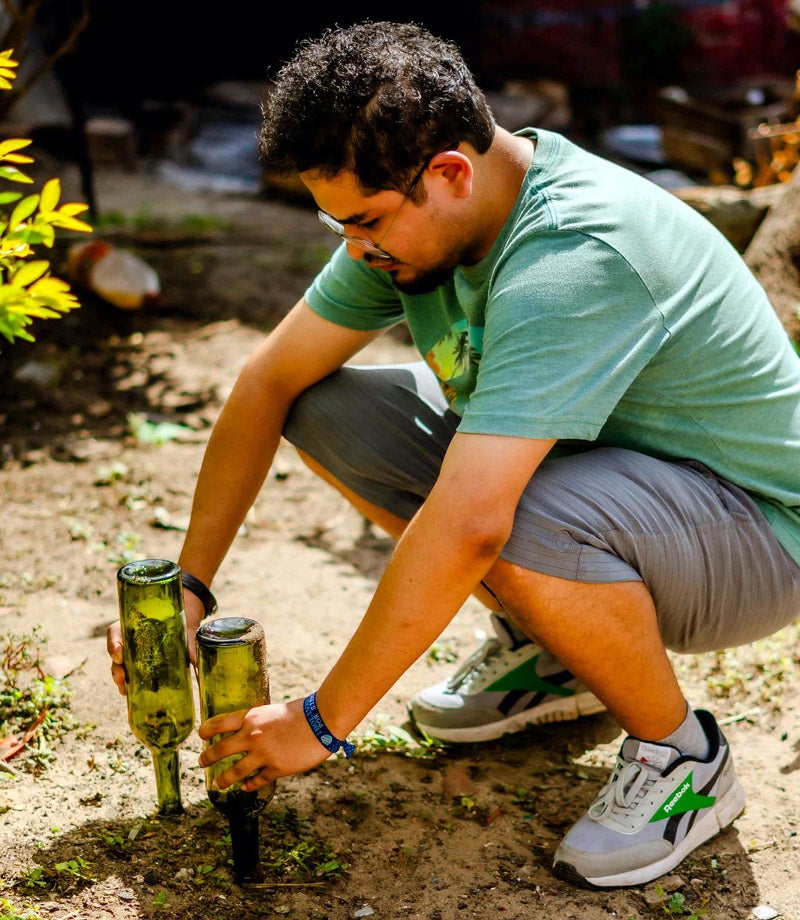 Summary
Summary
As of 2022, significant disease burdens persist in the Region, including millions at risk for the more than 30 diseases and conditions targeted by the Elimination Initiative. Progress toward elimination targets varies widely across diseases and countries. Seven diseases have been eliminated region-wide, including polio and several other vaccine-preventable diseases. Other diseases like malaria, onchocerciasis, and mother-to-child transmission of HIV and syphilis have been eliminated in some countries. However, many diseases – cervical cancer, tuberculosis, viral hepatitis, HIV/AIDS, and neglected and zoonotic diseases – still require substantial efforts to reach elimination targets. Factors hindering progress include poverty, lack of access to health care and sanitation, and environmental challenges. Governmental and intersectoral action will ensure access to prevention, screening, and treatment for populations affected by all diseases and conditions in the initiative.
Status of the elimination targets in the Americas
PAHO is monitoring progress toward specific indicators and targets for each of the diseases and conditions – more than 30 – included in the Elimination Initiative. The regional data portal includes elimination definitions, indicators, and targets for each disease and condition in the initiative. By the end of 2024, PAHO will enhance the monitoring process to include indicators to track progress toward the four lines of action. This will provide a comprehensive overview of progress and impact at both country and regional levels, beyond metrics aggregated by diseases.
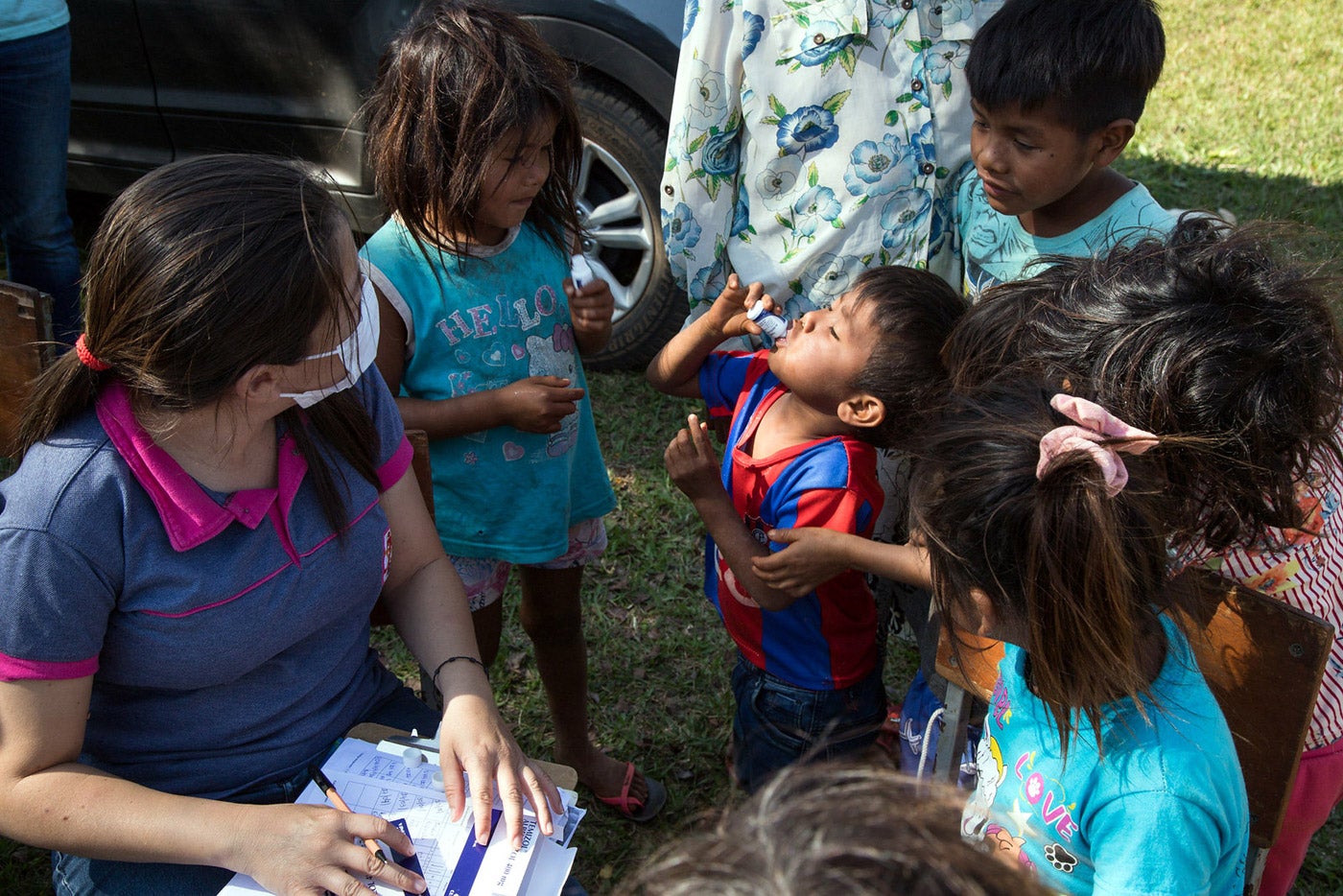 © PAHO
© PAHO
Box 5. Do each of the 30+ diseases and conditions need addressing in each country and territory in the Americas?
Not every disease target will be relevant for all countries and territories. The Region is diverse, with a range of climates, communities, inequalities, and risk factors that make certain diseases more prevalent in some areas. While some, like sexually transmitted infections and viral hepatitis, are relevant to all countries and territories, others are not. For example, vector-borne, zoonotic, and neglected infectious diseases affect only certain countries and specific areas and populations within countries. Therefore, each country should tailor integrated actions and road maps toward elimination based on the presence of each disease in the different contexts of the populations within the national territory.
The Elimination Initiative encompasses a diverse group of diseases and conditions targeted for elimination – or for those already eliminated, to maintain elimination status. Figure 4 lists the diseases and conditions and, of the 49 total countries and territories in the Elimination Initiative, it lists the number of countries and territories where each of these diseases and conditions are present.
Figure 4. Number of target countries and territories for each disease and condition in the Elimination Initiative
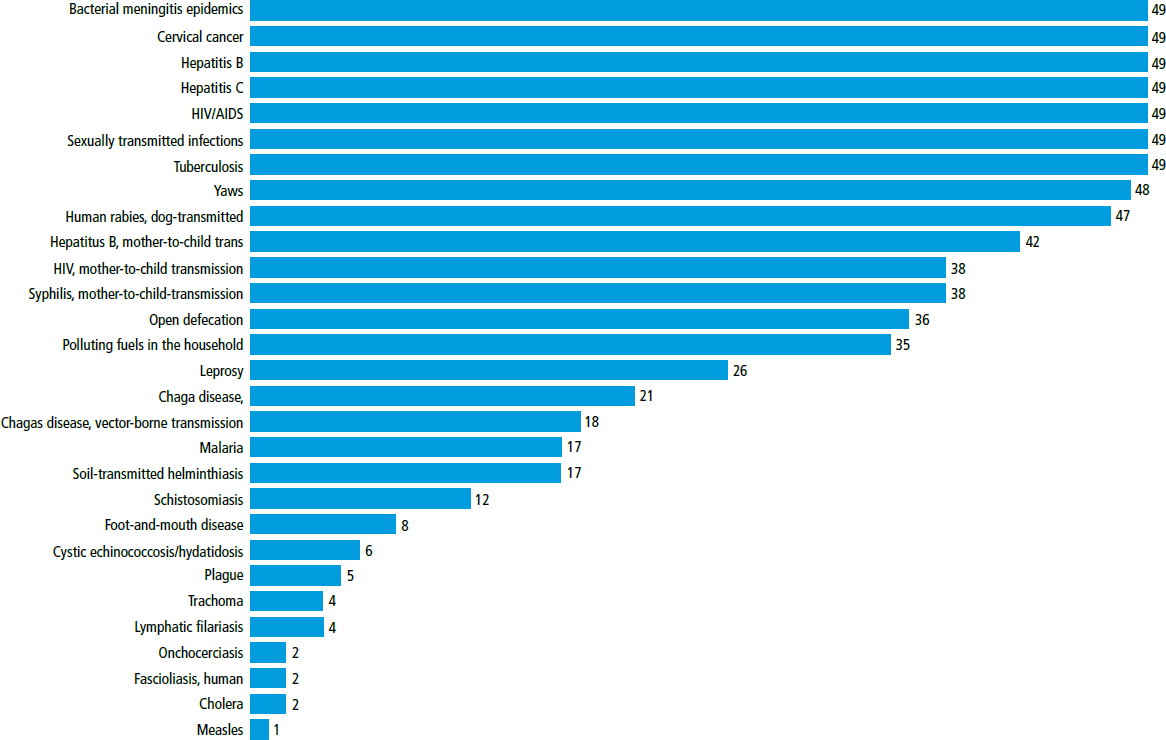
By the numbers
Disease burden of selected diseases in the Americas in 2022
![]()
Over 45 million children
under 15 years of age were at risk of intestinal parasitic infections
![]()
Over 21,000 new cases
of leprosy were reported
![]()
Over 3.9 million people
were living with HIV with approximately 170,000 new infections that year
![]()
Over 78,000 women
were diagnosed with cervical cancer
![]()
1.6 million people
were at risk for schistosomiasis
![]()
480,000 cases
of malaria were reported
Below, data for the diseases and conditions in the Elimination Initiative are presented based on the following categories: (1) targets have been achieved; (2) targets nearing achievement; and (3) targets are yet to be met.
Diseases and conditions for which the elimination targets have been achieved
Diseases eliminated throughout the Region
Seven diseases have been eliminated regionally, which include guinea-worm and six vaccinepreventable diseases: smallpox, poliomyelitis, rubella, congenital rubella, measles, and neonatal tetanus. Successful regional elimination of these diseases has been achieved through mass immunization, strengthened surveillance, public health education, and international collaboration supporting different countries' efforts.
The Region recorded its last case of poliomyelitis in 1991, and, in 1994, it became the first region in the world to be certified free of the disease. In July 2022, an unvaccinated patient with no recent travel history was diagnosed with vaccine-derived poliomyelitis in the United States, triggering immediate response. While the risk of polio reintroduction is declining in the Region, low vaccination coverage increases the likelihood of poliovirus mutation, potentially leading to a strain capable of causing infection and paralysis. The regional coverage of the third dose of the polio vaccine was 87% in 2023, compared to 80–83% in the previous three years. However, despite this progress, some countries have not yet reached the recommended vaccine coverage goal of 95% nationally1.
After a decade of vaccination campaigns reaching an estimated 250 million individuals across 32 countries, the last cases of endemic rubella in the Americas were reported in 2009. The Region was certified free of endemic rubella in 2015. The proportion of children receiving a first dose of measles, mumps, and rubella vaccine was 87% in 2023, higher than the 2022 level of 84%. However, this still has not reached PAHO’s recommended ideal of at least 95% coverage2.
The Region was certified measles-free in September 2016 – the only region in the world to have achieved this goal. Since then, it has reappeared in 14 countries, including the Bolivarian Republic of Venezuela and Brazil, where endemic transmission was reestablished in 2018 and 2019, respectively. The Bolivarian Republic of Venezuela was recertified as a country free of endemic measles in November 2023; Brazil interrupted the circulation of the virus in July 2022 and is pending recertification by the Regional Commission.
The Region eliminated maternal and neonatal tetanus in 2017. In 2022, seven cases of neonatal tetanus were reported in the Region. In 2023, regional coverage of the third dose of diphtheria, tetanus, and pertussis vaccine was 88%, higher than the 84% coverage reported in 2022.
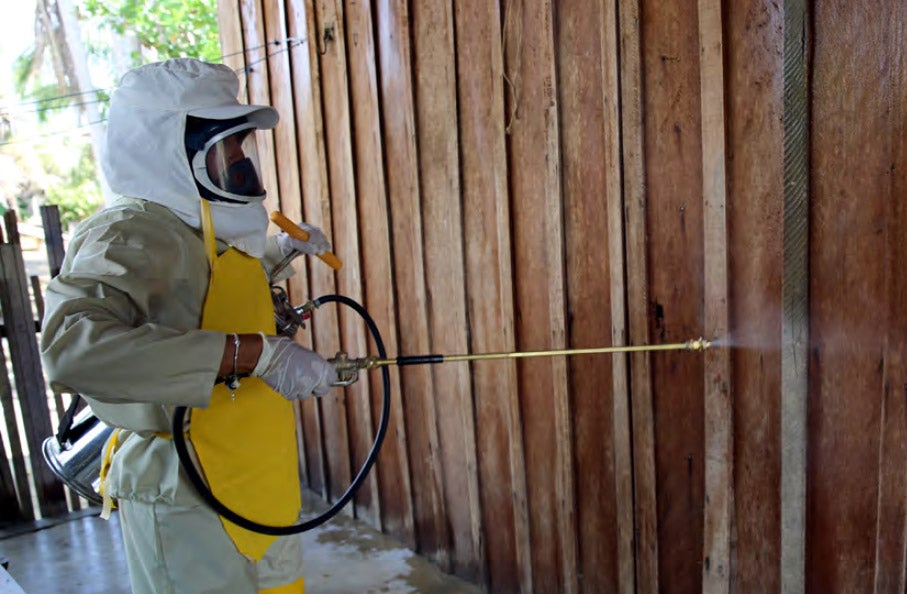 Significant progress has also been achieved in eliminating vector-borne diseases in the Region. There have been no cases of urban yellow fever transmitted by the Aedes aegypti mosquito since 2008, although a range of factors threaten this maintenance of elimination status. Urbanization, deforestation, and climate change expand mosquito habitats and breeding seasons. Population movement and inadequate vaccination coverage increase virus spread. Eliminating urban yellow fever requires expanded vaccination, improved surveillance, mosquito control, One Health initiatives, intercountry communication, and stronger public health systems.
Significant progress has also been achieved in eliminating vector-borne diseases in the Region. There have been no cases of urban yellow fever transmitted by the Aedes aegypti mosquito since 2008, although a range of factors threaten this maintenance of elimination status. Urbanization, deforestation, and climate change expand mosquito habitats and breeding seasons. Population movement and inadequate vaccination coverage increase virus spread. Eliminating urban yellow fever requires expanded vaccination, improved surveillance, mosquito control, One Health initiatives, intercountry communication, and stronger public health systems.
Diseases eliminated in some countries
Malaria has been eliminated in 19 countries. Between 2000 and 2022, the Region made good progress in reducing malaria burden: cases declined by approximately 64% (from 1.5 million to 550 000), and total malaria deaths were reduced by 60%, from 850 to 343. The most recent countries certified as malaria free are Paraguay (2018), Argentina (2019), El Salvador (2021), and Belize (2023)3.
The Region has also seen progress with mother-to-child transmission (MTCT), particularly in Caribbean countries and territories. Elimination of MTCT of syphilis and HIV has been achieved in 11 countries and territories (Anguilla, Antigua and Barbuda, Belize, Bermuda, Cayman Islands, Cuba, Dominica, Jamaica, Monserrat, Saint Kitts and Nevis, and Saint Vincent and the Grenadines).
Progress has also been made in the elimination of neglected infectious and zoonotic diseases. Transmission of foot-and-mouth disease has been interrupted in 12 out of the 18 countries where this disease occurs. No new confirmed plague cases have been reported for several years in five (Chile, Cuba, Mexico, Puerto Rico, and Uruguay) out of the 10 countries and territories where this disease is reported. Onchocerciasis (river blindness) has been eliminated in four (Colombia, Ecuador, Guatemala, and Mexico) of the six endemic countries in the Region – the only ones in the world to have achieved elimination targets. Three countries were removed from WHO's list of lymphatic filariasis endemic countries in 2011 (Costa Rica, Suriname, and Trinidad and Tobago).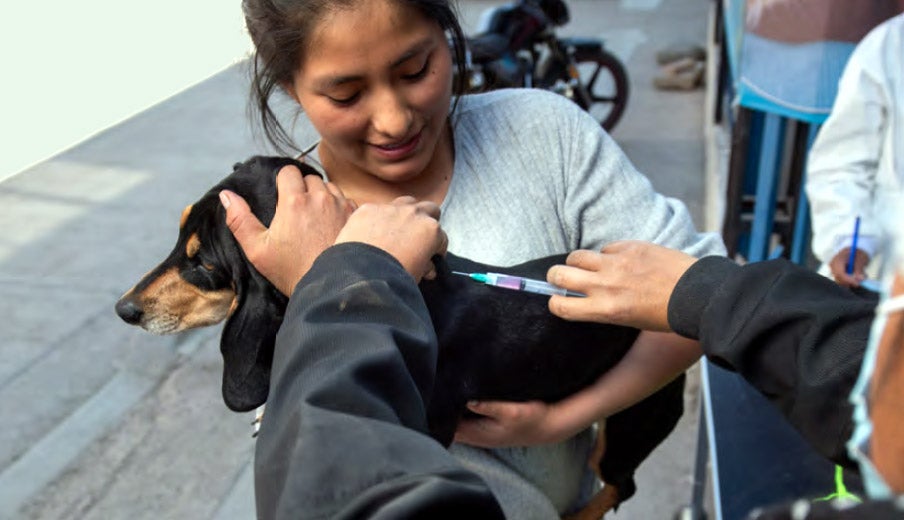 Meanwhile, Brazil is pending validation of elimination, the Dominican Republic interrupted mass drug administration (MDA) in 100% of the endemic area, and two countries are still endemic (Guyana and Haiti). Three countries (Chile, Paraguay, and Uruguay) have interrupted Chagas disease due to vector-borne transmission, and all endemic countries in the Region have universal screening of blood donors and blood products to prevent the transmission of Chagas disease. Trachoma was eliminated in Mexico (one of four endemic countries in the Americas) in 2017. Furthermore, in 2019, Mexico became the only country in the world to achieve the milestone of eliminating human rabies transmitted by dogs.
Meanwhile, Brazil is pending validation of elimination, the Dominican Republic interrupted mass drug administration (MDA) in 100% of the endemic area, and two countries are still endemic (Guyana and Haiti). Three countries (Chile, Paraguay, and Uruguay) have interrupted Chagas disease due to vector-borne transmission, and all endemic countries in the Region have universal screening of blood donors and blood products to prevent the transmission of Chagas disease. Trachoma was eliminated in Mexico (one of four endemic countries in the Americas) in 2017. Furthermore, in 2019, Mexico became the only country in the world to achieve the milestone of eliminating human rabies transmitted by dogs.
Significant progress has been also made in eliminating cholera over the past 15 years. However, while 47 countries and territories met their elimination targets, new indigenous cases of epidemic V. cholerae appeared in the Dominican Republic and Haiti in 2023 (149 and 56 355 cases, respectively). In Haiti, the ongoing humanitarian and security crisis made it harder to track cholera cases, as people had limited access to healthcare and testing facilities. Effective cholera elimination and maintenance requires robust surveillance and timely case reporting, alongside improved water and sanitation infrastructure and public education campaigns.
From 1900 to August 2024, 499 "elimination events" have occurred in the Americas. An elimination event happens when a country or territory successfully eliminates a disease or condition. To protect the Region's achievements, each Member State needs to strengthen monitoring systems, continue vaccination programs (especially among communities with low vaccination coverage), counter misinformation, and collaborate across different sectors to reduce the impact of climate change, which could bring back some diseases. Addressing communities’ social, economic and cultural aspects is crucial. In this process, this necessitates involving communities not only by raising awareness about the disease risk and emphasizing the ongoing need for prevention measures but also improving their participation in the development of health programs and activities.
Diseases and conditions for which elimination targets have nearly been achieved
For some diseases and conditions, evidence shows that elimination targets have been achieved in certain countries, but the process of certification, verification, or validation is not yet complete.
Several countries are close to eliminating some neglected infectious and zoonotic diseases. While current evidence suggests transmission of yaws has halted across the entire Region, no country in the Region – except for Ecuador – has yet confirmed this status. While reports of yaws significantly declined after 1970, many countries ceased surveillance necessary to detect resurgence and certify elimination. Despite Colombia last reporting confirmed yaws cases in 1992 and Haiti in 2015, both countries reported suspected cases to PAHO between 2014 and 2017. Confirming the disease’s absence in these two countries requires reviewing past records, gathering new information, and conducting clinical and serological surveys in previously endemic areas.
Human rabies transmitted by dogs is close to being eliminated in 37 countries. Actions for the elimination of this disease in the Americas began in 1983 with the launch of a regional rabies program. Since then, the incidence in the Region has been reduced by about 98%, from 300 cases reported in 1983 to five cases in 2023. This progress is the result of massive canine vaccination campaigns at the regional level, awareness-raising efforts, increased availability of pre-and post-exposure prophylaxis, improved quality of immunobiological treatments and strengthened surveillance and diagnosis capacities in the countries.
Foot-and-mouth disease is close to being eliminated in 12 countries. Notably, South America has been free of foot-and-mouth disease for over a decade and is moving toward eradication. The last reported outbreaks in South America occurred in 2017 and 2018 in Colombia and were allegedly associated with illegal animal introductions on the border with the Bolivarian Republic of Venezuela. Colombia was again declared free of foot-and-mouth disease with vaccination in 2020. Progress toward the interruption of transmission (contributing to the eradication goal) of footand- mouth disease in South America is the result of prevention, surveillance, and control measures, including livestock vaccination, early detection, and rapid control of outbreaks.
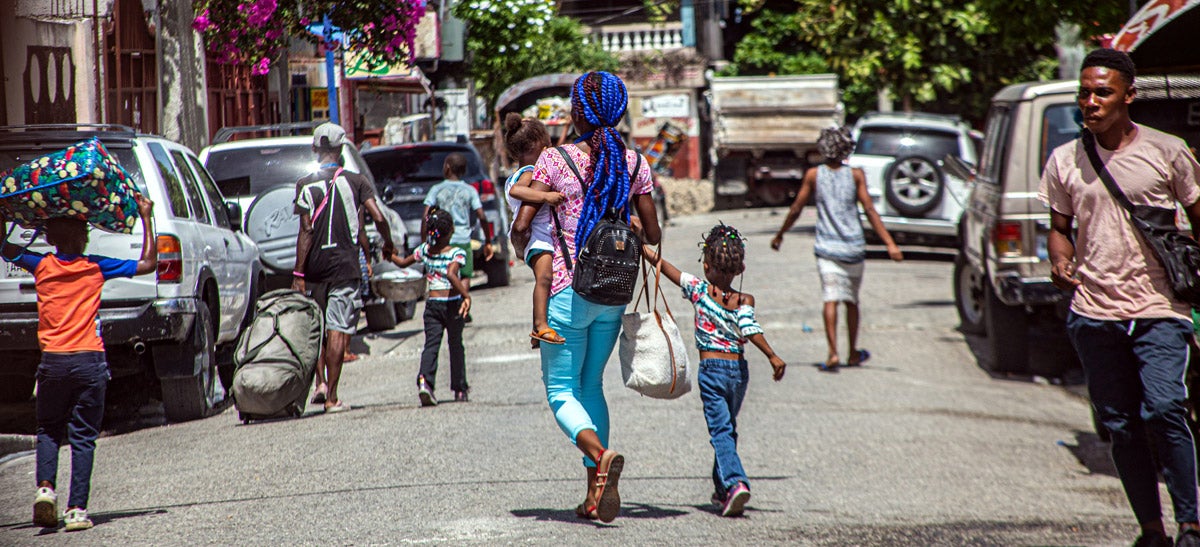 © PAHO
© PAHO
Although the countries have not provided confirmation, health officials suspect that nine countries and territories in the Caribbean (Antigua and Barbuda, Dominican Republic, Guadeloupe, Martinique, Montserrat, Puerto Rico, Saint Kitts and Nevis, Saint Lucia, and Sint Maarten) have eliminated schistosomiasis, with the last human case reported in 2010. Chile is gathering data and aligning with WHO procedures to document its status in meeting the milestones of transmission interruption and leprosy elimination. In Brazil, plague is close to being eliminated, with no reported cases for several years. As of 2023, Suriname was close to completing three years without indigenous transmission of malaria, a condition established to request WHO certification.
Elimination of MTCT of hepatitis B is close to being achieved in 17 countries. The prevalence of hepatitis B in the Region has decreased in recent decades, mainly due to the introduction of the hepatitis B vaccine in the early 1990s. The prevalence of chronic hepatitis B infection among children younger than 5 years in the Americas is estimated to be <0.5%, the lowest among WHO regions, making it feasible to eliminate vertical transmission and early childhood transmission of hepatitis B virus.
The Region has also made progress toward the elimination of the two environmental risk factors included in the Elimination Initiative: 20 countries are close to eliminating open defecation, and 13 countries are close to eliminating the use of polluting fuels within households.
Over the next several years, up to 152 elimination events could be realized. The Region holds significant potential to accelerate efforts and achieve elimination targets for diseases and conditions that are on the brink of being eliminated. For some of the diseases and conditions mentioned above, confirming the current epidemiological status is the key step, as PAHO and Member States suspect that elimination has already been achieved. For others, closing gaps in interventions, enhancing surveillance, and compiling evidence are the critical components needed to reach the final milestone.
Diseases and conditions for which the elimination targets still need to be achieved
For some diseases – such as cervical cancer, tuberculosis, hepatitis C, hepatitis B, HIV/AIDS, bacterial meningitis, and sexually transmitted infections – none of the countries in the Region have yet achieved elimination targets. Eliminating MTCT of HIV, syphilis, hepatitis B, and Chagas disease is still a challenge in several countries, along with the elimination of malaria, cholera, open defecation, and use of polluting fuels in the household. Neglected infectious and zoonotic diseases still affect millions across the Region, particularly those lacking access to basic services – including health, education, water, and sanitation.
Over 78 706 women in the Americas were diagnosed with cervical cancer in 2022, resulting in nearly 40 135 deaths. Coverage of the human papillomavirus (HPV) vaccine, crucial for preventing cervical cancer, varies dramatically, from 2% in some countries, to 87% in Canada. Barriers to higher vaccination include policy and access issues, as well as vaccine misconceptions. HPV testing with “screen and treat” is effective but adoption is slow due to costs and logistics. Improving access through advocacy, pooled procurement (including PAHO’s Strategic Fund), and sustained support is key to progress. In addition to the HPV vaccine, the elimination of cervical cancer as a public health problem necessitates screening and treatment of precancer, early detection and prompt treatment of invasive cancers, and palliative care.
In 2022, tuberculosis was the world's second leading cause of death from a single infectious agent (only COVID-19 being higher). In the Americas, more than 325 000 people continue to fall ill with tuberculosis every year, of which 83 000 remain undiagnosed and untreated4, 5. More than 240 000 people with tuberculosis in the Region had access to diagnosis and treatment in 2022, the highest number in the past 20 years, reflecting the significant efforts being made by countries. However, the estimated incidence of tuberculosis and the estimated number of deaths continue to rise. While the Region has recovered from disruptions in tuberculosis services caused by the COVID-19 pandemic, the tuberculosis mortality rate reached values not seen in over a decade, taking more than 35 000 lives in 20226. To eliminate tuberculosis, countries need to accelerate new technologies such as artificial intelligence-assisted radiography for tuberculosis screening, and scale up existing interventions like rapid molecular tuberculosis tests, preventive treatment and shorter totally oral treatments. However, to ensure these technologies reach the most underserved and distant communities, it is vital to address underlying social determinants of health. This will allow countries to concentrate efforts on bringing tuberculosis detection and treatment closer to those living in situations of vulnerability.
In the Americas, an estimated 5 million people had chronic hepatitis B infection, and approximately 20 000 died from hepatitis B-related causes in 20227.
Data from 2022 show wide variances of hepatitis B rates within the Region, with Haiti having the highest rate followed by a group of Caribbean countries with similar rates (Antigua and Barbuda, Bahamas, Barbados, Dominica, Jamaica, and Saint Lucia). For hepatitis C, an estimated 5.3 million had the disease and 38 000 died from hepatitis C-related causes. The highest rate for hepatitis C was reported in the Bolivarian Republic of Venezuela, followed by Cuba and Saint Kitts and Nevis. Accelerating measures to improve prevention, diagnosis, and treatment of hepatitis B and C is key to achieving elimination.
Under the Elimination Initiative, the HIV monitoring indicators include AIDS-related deaths and incidence rate. As of 2023, an estimated 4 million people were living with HIV in the Americas, with 2.9 million receiving antiretroviral therapy (ART)8. Despite this, an estimated 11% of people with HIV in the Region are unaware of their infection, and about one-third are diagnosed late with advanced disease8, 9. The number of new infections in Latin America is estimated to have increased by 9% from 2010 to 2023, with approximately 120 000 new infections in 2023. Meanwhile, the Caribbean had a reduction of 22% from 2010 to 2023, down from an estimated 19 000 new cases to 15 000 per year8, 10. According to 2021 estimates, three key populations – men who have sex with men, transgender women, and female sex workers – represent 60% of new infections in Latin America and 44% of new infections in the Caribbean8. To accelerate HIV elimination, urgent actions needed include: strengthening ART access, increasing testing, ensuring availability of pre-exposure prophylaxis, providing sexual education, implementing behavior change interventions, and addressing stigma, discrimination, and other structural barriers.
Elimination of MTCT of Chagas, syphilis, HIV, and hepatitis B remains a significant challenge in the Americas. Although 11 countries and territories have eliminated the MTCT of syphilis and HIV, there were still an estimated 183 000 pregnant women with syphilis and 68 000 cases of congenital syphilis regionally in 202211. The estimated HIV vertical transmission rate for Latin America and the Caribbean is 15%. Despite regional progress on eliminating MTCT of hepatitis B, an estimated 34 000 children under 5 in the Americas had chronic hepatitis B infection in 2022. Maternal and child health care systems throughout the Region need to address MTCT – including increasing awareness of these diseases, increasing the coverage of maternal testing and treatment (when applicable), improving vaccination when applicable, and ensuring safe childbirth practices.
 While 19 countries have achieved elimination targets and some countries and territories such as Costa Rica, Dominican Republic, Ecuador, French Guiana, Mexico, and Suriname are on track on the elimination after significant progress in reducing the transmission, malaria remains a public health problem in the Americas, particularly among rural and impoverished communities. In 2022, about 482 000 confirmed cases and 89 deaths were reported in the Region of the Americas. By 2022, three countries – Brazil, Colombia, and the Bolivarian Republic of Venezuela – accounted for an estimated 73% of all cases region-wide3. Regional malaria elimination faces several challenges, including the increase in gold mining activity, movement of people for social and economic reasons, and limited healthcare access for migrants, hard-to-reach populations, and marginalized groups. Effective elimination requires effective intersectoral action to address the barriers that exist to providing access to malaria diagnosis and treatment to affected communities.
While 19 countries have achieved elimination targets and some countries and territories such as Costa Rica, Dominican Republic, Ecuador, French Guiana, Mexico, and Suriname are on track on the elimination after significant progress in reducing the transmission, malaria remains a public health problem in the Americas, particularly among rural and impoverished communities. In 2022, about 482 000 confirmed cases and 89 deaths were reported in the Region of the Americas. By 2022, three countries – Brazil, Colombia, and the Bolivarian Republic of Venezuela – accounted for an estimated 73% of all cases region-wide3. Regional malaria elimination faces several challenges, including the increase in gold mining activity, movement of people for social and economic reasons, and limited healthcare access for migrants, hard-to-reach populations, and marginalized groups. Effective elimination requires effective intersectoral action to address the barriers that exist to providing access to malaria diagnosis and treatment to affected communities.
Thirteen neglected infectious and zoonotic diseases are included in the Elimination Initiative. Three (plague, foot-and-mouth disease, and yaws) are nearly or suspected fully eliminated. Progress on the remaining diseases is detailed below.
Each year, over 20 000 cases of leprosy are reported in the Americas, 90% of which are in Brazil. There are 17 countries with fewer than 10 annual reported cases on average, which are on track to potentially interrupt transmission in the coming years (Antigua and Barbuda, Bahamas, Barbados, Belize, Chile, Dominica, El Salvador, Grenada, Guatemala, Honduras, Jamaica, Nicaragua, Panama, Saint Kitts and Nevis, Saint Lucia, Saint Vincent and the Grenadines, and Uruguay). In addition, eight countries (Plurinational State of Bolivia, Costa Rica, Ecuador, Guyana, Haiti, Peru, Suriname, and Trinidad and Tobago) are well-positioned to make significant strides toward leprosy elimination by enhancing their efforts, as they report between 11 and 100 leprosy cases annually on average.
Brazil and the Bolivarian Republic of Venezuela have widespread schistosomiasis transmission where approximately 25 million people are at risk of infection, and Suriname has focal transmission. In the Americas, soil-transmitted helminthiasis presents a public health problem in 17 countries, affecting nearly 46 million children under 15 years of age. Six countries (Belize, Dominican Republic, El Salvador, Honduras, Nicaragua, and Paraguay), where around 10 million children under 15 years old need preventive chemotherapy, are implementing successful control programs, including annual deworming and treatment.
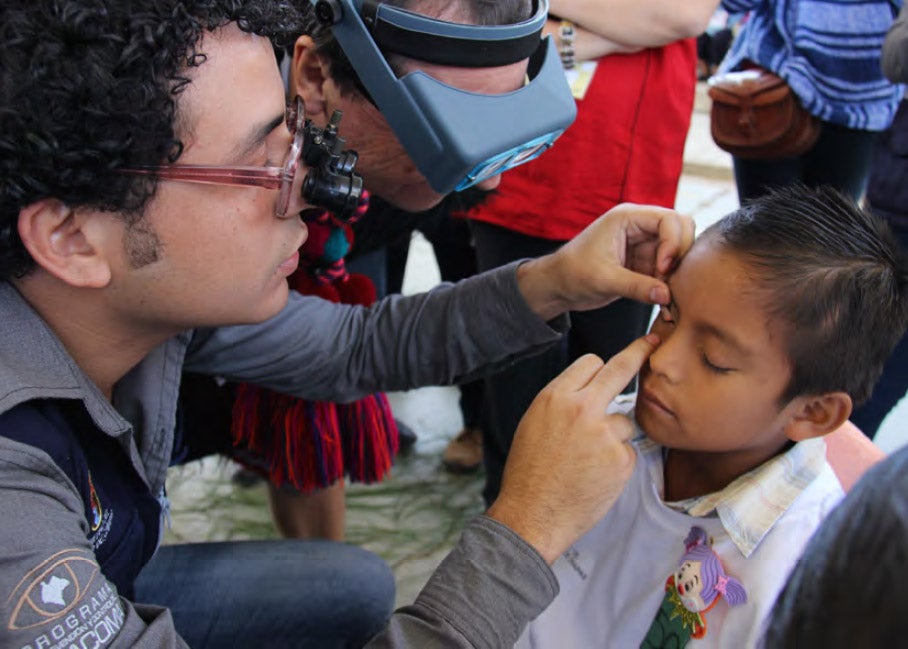 In Guyana and Haiti, in spite of significant progress, an estimated 5.1 million people are at risk of lymphatic filariasis. Progress is measured by the number of districts that stopped MDA. Haiti went from 140 communes needing MDA to 18 (a reduction of 87.2%) and Guyana went from eight regions with MDA to two (a reduction of 75%). Brazil, Colombia, Guatemala, and Peru continue efforts to eliminate trachoma with an estimated 5.6 million people requiring preventive chemotherapy. Guatemala is poised to achieve the elimination target by 2025, and PAHO is supporting other countries in the Americas to find out whether more populations are at risk, a necessary step to eventually declare the Region free of trachoma. The last remaining active transmission focus of onchocerciasis is in the Yanomami Indigenous area bordering Brazil and the Bolivarian Republic of Venezuela, where approximately 36 000 people still require preventive chemotherapy.
In Guyana and Haiti, in spite of significant progress, an estimated 5.1 million people are at risk of lymphatic filariasis. Progress is measured by the number of districts that stopped MDA. Haiti went from 140 communes needing MDA to 18 (a reduction of 87.2%) and Guyana went from eight regions with MDA to two (a reduction of 75%). Brazil, Colombia, Guatemala, and Peru continue efforts to eliminate trachoma with an estimated 5.6 million people requiring preventive chemotherapy. Guatemala is poised to achieve the elimination target by 2025, and PAHO is supporting other countries in the Americas to find out whether more populations are at risk, a necessary step to eventually declare the Region free of trachoma. The last remaining active transmission focus of onchocerciasis is in the Yanomami Indigenous area bordering Brazil and the Bolivarian Republic of Venezuela, where approximately 36 000 people still require preventive chemotherapy.
Chagas disease is endemic in 21 countries where an estimated 6–8 million people are infected. About 30 000 new cases occur annually due to vector-borne transmission, and approximately 9000 more are due to MTCT. Sixty-five million people are estimated to be at risk of contracting the infection and about 12 000 deaths are caused by this disease each year, mostly in Argentina, the Plurinational State of Bolivia, and Brazil. Eighteen countries in the Region have interrupted transmission by the main domestic vector of Chagas disease at the national level, but more remains to be done. Although only one country achieved the status of free of human rabies mediated by dog (Mexico), countries of the Caribbean have never reported the disease, and others have not reported the occurrence for decades. Only four countries reported human deaths due to dog-mediated rabies in the Region in 2023 (Plurinational State of Bolivia, Haiti, Peru, and Bolivarian Republic of Venezuela). There has been some progress in addressing cystic echinococcosis/hydatidosis with improvements in elimination capacities, such as the case of Argentina, Brazil, Chile, Peru, and Uruguay, all of which have included interventions in their national plans. It is still necessary, however, to increase the sensitivity of surveillance and improve the quality of available information. Mainly due to its chronic course and late diagnosis, echinococcosis is often expensive and complicated to treat and may require extensive surgery and/or prolonged drug therapy. Animal fasciolosis is widespread in the Region, but human fascioliasis is a public health problem only in Peru and the Plurinational State of Bolivia, where approximately 250 000 people (primarily Indigenous communities) are at risk of infection due to socioeconomic and cultural determinants. Since 2007, the Plurinational State of Bolivia’s annual deworming efforts in La Paz have significantly reduced fascioliasis, and elimination is likely within the next four years. Peru faces widespread human fascioliasis in several regions, particularly in high Andean and rural areas.
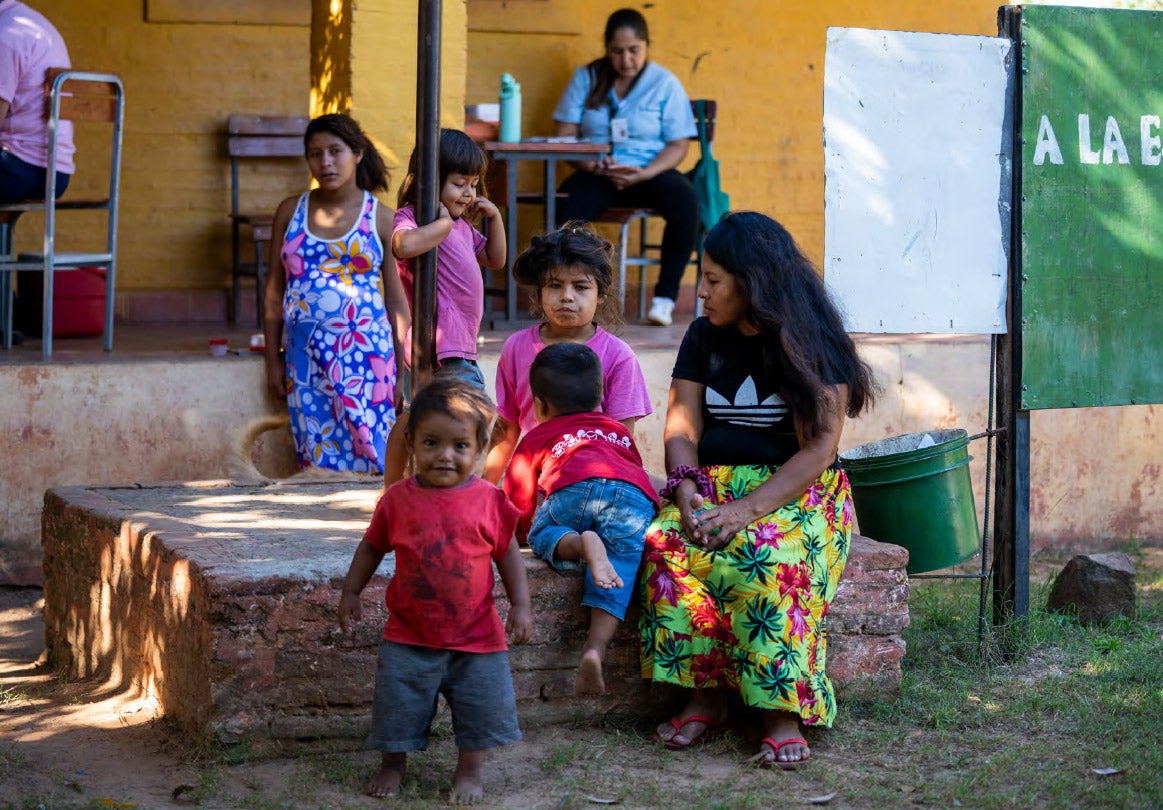 © PAHO
© PAHO
To achieve disease elimination of neglected infectious and zoonotic diseases and conditions, countries must enhance case management, monitoring, and documentation while addressing complications, preventing disabilities, and combating stigma. Implementing population-based interventions is crucial, including preventive chemotherapy, improved water and sanitation, hygiene education, control of vectors, and addressing communities’ social, economic, and cultural aspects. Disease-specific activities like deworming, animal vaccination, and food inspection are also important. Adopting an integrated One Health approach that addresses humans, animals, and the environment is also key to sustaining progress and achieving elimination goals.
As reported by the Joint Monitoring Program in 2021, a total of 9.1 million people practiced open defecation in the Region11. The practice is especially prevalent in rural and low-income urban areas. In 2022, six countries reported having between 1% and less than 4% of the population practicing open defecation (Colombia, Dominican Republic, Guatemala, Panama, Peru, and Suriname,) while the Plurinational State of Bolivia, Honduras, and Saint Lucia reported proportions between 4% and 9%, and Haiti reported 17.7%. More support is needed to strengthen water, sanitation, and hygiene (WASH) interventions and improve access to safely managed sanitation services, especially for those living in situations of vulnerability, including rural and Indigenous communities.
 Fourteen countries have eliminated the use of polluting fuels in the household, and regional use has decreased by 10 million individuals over the last decade. However, 74 million people in the Region still relied on polluting fuels for cooking or heating sources in 2021. This issue primarily affects rural and low-income urban areas. In five countries (Guatemala, Haiti, Honduras, Nicaragua, and Paraguay), more than 30% of the population still uses polluting fuels. Eight countries are close to the elimination goal (<10% of the population using polluting fuels: Colombia, Cuba, Dominican Republic, Ecuador, El Salvador, Saint Lucia, Saint Vincent and the Grenadines, and Suriname) and in eight countries, the percentage is between 10% and 30% (Belize, Plurinational State of Bolivia, Dominica, Grenada, Guyana, Jamaica, Mexico, and Peru). Rural areas (24.9%) are more affected than urban areas (3.5%). Solutions include improving access to clean energy, enhancing infrastructure, and raising awareness about health and environmental risks.
Fourteen countries have eliminated the use of polluting fuels in the household, and regional use has decreased by 10 million individuals over the last decade. However, 74 million people in the Region still relied on polluting fuels for cooking or heating sources in 2021. This issue primarily affects rural and low-income urban areas. In five countries (Guatemala, Haiti, Honduras, Nicaragua, and Paraguay), more than 30% of the population still uses polluting fuels. Eight countries are close to the elimination goal (<10% of the population using polluting fuels: Colombia, Cuba, Dominican Republic, Ecuador, El Salvador, Saint Lucia, Saint Vincent and the Grenadines, and Suriname) and in eight countries, the percentage is between 10% and 30% (Belize, Plurinational State of Bolivia, Dominica, Grenada, Guyana, Jamaica, Mexico, and Peru). Rural areas (24.9%) are more affected than urban areas (3.5%). Solutions include improving access to clean energy, enhancing infrastructure, and raising awareness about health and environmental risks.
As the current data show, a number of strategic areas require more effort to achieve elimination targets for a range of diseases and conditions. Factors such as poverty, lack of education, and stigma play significant roles in the ongoing transmission of these diseases. Progress toward elimination hinges on expanding interventions to reach underserved communities, intensifying intersectoral efforts to reduce inequalities, strengthening first level of care to deliver integrated services, and fostering meaningful community engagement.
Gaps in data/information
While the Elimination Initiative has already begun advancing the implementation and measurement of disease elimination in the Region, it is important to highlight gaps in data and information that prevent countries from fully recognizing the initiative’s full potential. Data gaps in disease elimination efforts are multifaceted, stemming from disparities in global attention, geographical coverage, and population focus. High-profile diseases like HIV, tuberculosis, and malaria often have more comprehensive data, while neglected diseases suffer from information scarcity. Urban areas generally have better data availability compared to remote regions, and structural inequities lead to inadequate surveillance among certain populations, particularly Indigenous communities. While PAHO Member States have made progress in generating national-level data, there is a pressing need for higher-quality, disaggregated data at subnational levels to understand trends, inequalities, and specific demographic impacts.
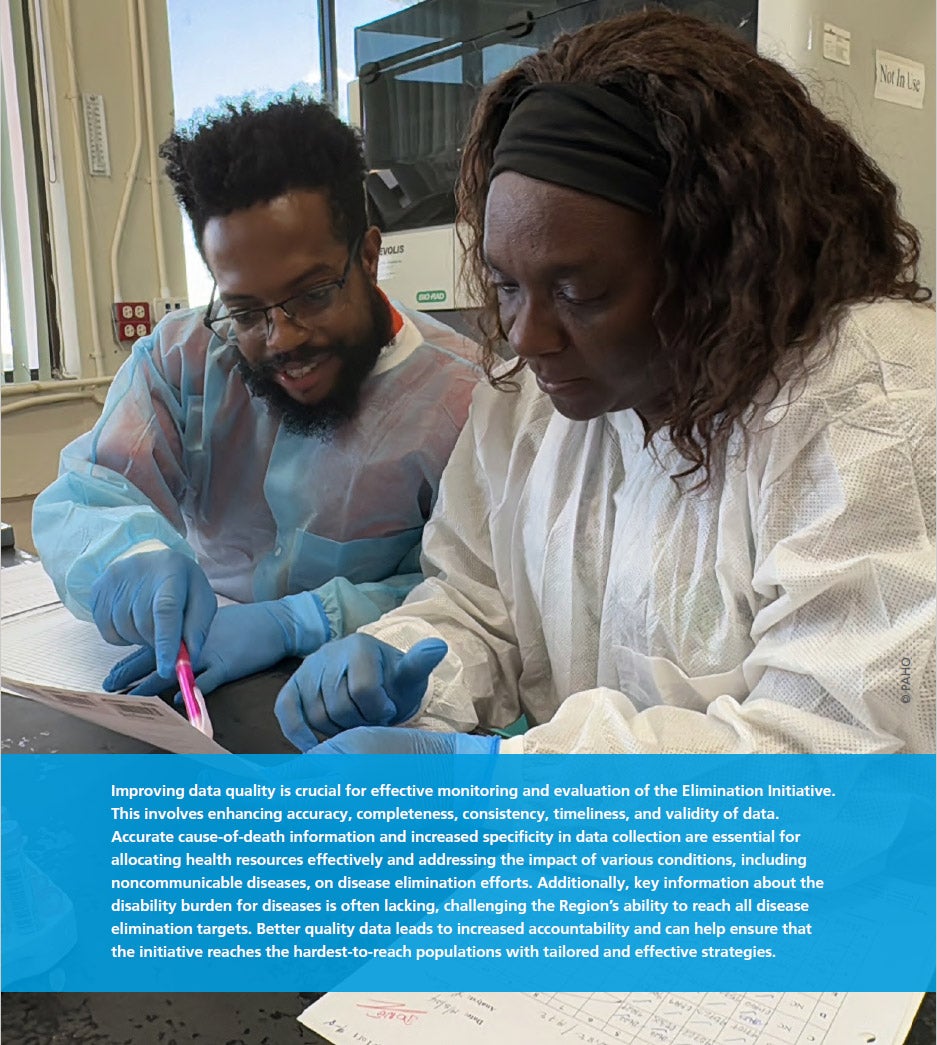 © PAHO
© PAHO
References
- Pan American Health Organization. 18th meeting of the Regional Commission for Certification of Polio Eradication in the Region of the Americas (RCC). Washington, D.C.: PAHO; 2024 [cited 11 September 2024]. Available from: https://www.paho.org/en/news/26-7-2024-18th-meeting-regional-commission-certification-polio-eradication-region-americas-rcc.
- Pan American Health Organization. PAHO briefs health professionals on measles as cases increase in the Americas. Washington, D.C.: PAHO; 2024 [cited 11 September 2024]. Available from: https://www.paho.org/en/news/21-3-2024-paho-briefs-health-professionals-measles-cases-increase-americas.
- World Health Organization. World malaria report 2023. Geneva: WHO; 2023. Available from: https://iris.who.int/handle/10665/374472.
- World Health Organization. Tuberculosis profile: WHO/PAHO Region of the Americas. Geneva: WHO; 2022 [cited 11 September 2024]. Available from: https://www.who.int/docs/default-source/documents/tuberculosis/annex-3-global-tb-report-2019-regional-and-global-profiles.pdf?sfvrsn=7f989e9f_2.
- World Health Organization. Global tuberculosis report 2023. Geneva: WHO; 2023. Available from: https://iris.who.int/handle/10665/373828.
- Pan American Health Organization. Tuberculosis. Washington, D.C.: PAHO; [date unknown] [cited 11 September 2024]. Available from: https://www.paho.org/en/topics/tuberculosis.
- Global hepatitis report 2024: action for access in low- and middle-income countries. Geneva: World Health Organization; 2024. Licence: CC BY-NC-SA 3.0 IGO. Availabe at: https://iris.who.int/bitstream/handle/10665/376461/9789240091672-eng.pdf?sequence=1
- World Health Organization. HIV statistics globally and by WHO Region, 2024. Geneva: WHO; 2024. Available from: https://cdn.who.int/media/docs/default-source/hq-hiv-hepatitis-and-stis-library/j0482-who-ias-hiv-statistics_aw-1_final_ys.pdf?sfvrsn=61d39578_3.
- Pan American Health Organization. HIV/AIDS. Washington, D.C.: PAHO; [date unknown] [cited 11 September 2024]. Available from: https://www.paho.org/en/topics/hivaids.
- Pan American Health Organization. HIV situation in the Americas. Washington, D.C.: PAHO; [date unknown] [cited 9 September 2024]. Available from: https://www.paho.org/en/hiv-situation-americas.
- Pan American Health Organization. Syphilis. Fact sheet. Washington, D.C.: PAHO; [date unknown] [cited 9 September 2024]. Available from: https://www.paho.org/en/topics/syphilis.
- Pan American Health Organization. Water and sanitation. Washington, D.C.: PAHO; [date unknown] [cited 10 September 2024]. Available from: https://www.paho.org/en/topics/water-and-sanitation.




